
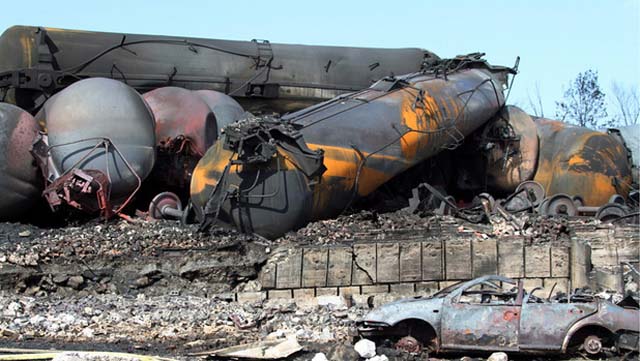
Some remains of the Lake Megantic derailment - Date/Photographer unknown - Surete du Quebec.
11 July 2013 Lake Megantic Marks Canada's
7th Runaway Train Since 2006 Canada - It is still not confirmed why the oil-tanker train that devastated the town of Lake Megantic was able to barrel down the tracks unattended. But it is not the only runaway train in Canada in recent years.
The federal Transportation Safety Board has published investigation reports of six major incidents involving a runaway train, or section of a train, since 2006. The Lake Megantic case, which involved a train operated by the Montreal Maine & Atlantic Railway, will be the seventh.
A common issue in these runaway cases is the braking systems, especially hand brakes. That is the mechanical device that forces the brake shoes against the wheel treads to prevent the wheels from moving, or to slow their motion.
The force on the wheels is proportionate to the force exerted by the person applying the hand brake.
Edward Burkhardt, the chairman of MMA, told reporters on Wednesday that "adequate hand brakes were not set on this train and it was the engineer's responsibility to set them."
He said that hand brakes were set on the locomotives and that the engineer, "told us he applied 11 hand brakes and our general feeling is, now, that that is not true."
Here's a look at recent runaway train cases. 18 Jan 2012 - Hanlon, Alberta.
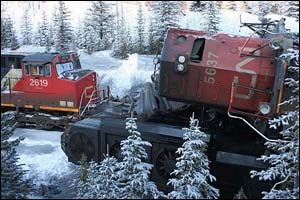
After 13 runaway loaded coal cars collide with a
stationary train - 18 Jan 2012 Photographer unknown - TSB.
|
Thirteen loaded coal cars belonging to CN Rail, which had been set out the previous day in a siding, rolled uncontrolled down a one percent grade for about 4.8 kilometres and collided with the head end of a stationary train.
Nine of the 13 coal cars and the three leading locomotives from the stationary train derailed. One crew member was seriously injured, two sustained minor injuries. About 2,800 litres of fuel and 670 tonnes of coal were spilled. About 75 metres of track was damaged.
The TSB analysis suggested that the runaway resulted from an insufficient number of hand brakes being applied when the cars were left at the siding.
The requirement was for two hand brakes, but just one was applied. However, given the weight of the cars and the grade, the TSB estimated that at least five hand brakes should have been used. 11 Dec 2011 - Doree, Quebec. The locomotive engineer had secured a freight train belonging to Quebec North Shore & Labrador Railway and loaded with iron ore after the train had experienced problems with its automatic and dynamic brakes, which use the trains electric traction motors.
An hour later, the train's air brakes released and the 35 hand brakes the engineer had applied proved not enough to hold the train. The engineer, who was beside the train while waiting for assistance, saw the train moving and jumped onboard the lead locomotive.
He applied the dynamic brakes, which were not working properly, but the train continued to accelerate as it descended the grade.
Only when the track leveled off did the train finally stop, intact. No one was injured.
A Transport Canada inspection later found that the Labrador Iron Mines cars included many with air brakes that "were not applying, or were not remaining applied, and that several hand brakes were not operating well."
The TSB said that 57 hand brakes working properly would have been needed to secure the train. The rules then in effect required a minimum of 12. 11 Feb 2009 - Nanticoke, Ontario. A runaway train belonging to Southern Ontario Railway with four locomotives and 43 cars (14 with dangerous goods, including gasoline), travelled almost three kilometres before a derail switch did what it was designed to do.
Nine cars derailed, preventing the train from entering a hydro plant.
"The crew left the train unattended on a one percent grade, without the train being properly secured," the TSB reported, noting a series of "deviations from standard operating practices associated with train securement."
There were no injuries, but 31,000 litres of gasoline were spilled and 90 metres of track were destroyed.
"Securing a train made up predominantly of dangerous and special dangerous commodities, adjacent to a major refinery on a descending grade, requires increased vigilance to safely complete the task," the TSB report concluded. 29 Dec 2008 - Waneta, British Columbia.
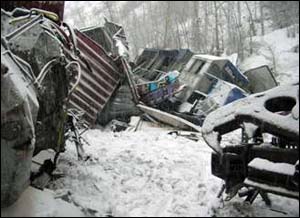
The engineer, unable to reduce his train's speed, jumped
into heavy snow before his train collided with stationary rail
cars and derailed - 29 Dec 2008 Photographer unknown - TSB.
|
A freight train operated by Kettle Falls International Railway with 12 cars and two locomotives started moving and quickly began to head down a steep grade.
The locomotive engineer was unable to reduce the train's speed, and with the train accelerating past 32 km/h, he decided to jump from the train, landing in deep snow.
The runaway train collided with stationary cars after travelling about 4.5 kilometres, causing it to derail, along with some of the stationary cars.
The engineer received minor injuries from his jump, 13,600 litres of fuel were spilled, and a highway was blocked for two days. All but one of the derailed cars were destroyed.
The TSB concluded the main reasons the train would not slow down was a result of insufficiently charged brakes along with operator error when applying the emergency brakes. 3 Sep 2006 - Log Cabin, British Columbia.
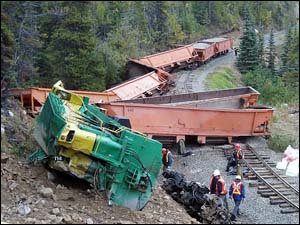
A locomotive derailed along with 6 overloaded ballast cars
- 3 Sep 2006 Photographer unknown - TSB.
|
A work train with one locomotive and eight cars loaded with gravel operated by the White Pass & Yukon Route became a runaway while travelling down a steep grade. After failing to bring the train under control with the brakes, the conductor jumped, landing in a small stream.
The train, which reached 72 km/h, derailed on a sharp curve. The three other crew members were trapped inside. Bruce Harder, 45, was killed, and the other two sustained serious injuries, as did the conductor.
According to the TSB, the train was too heavy due to overloading, and it was "likely that the brake systems on all of the ballast cars were functioning at a diminished capacity." 29 Jun 2006 - near Lillooet, British Columbia.
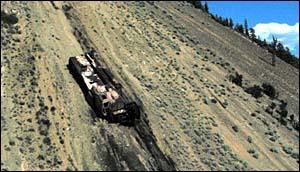
Derailed locomotive CN 9606 came to rest about 240 metres
down the canyon embankment - 29 Jun 2006 Photographer
unknown - TSB.
|
A CN locomotive pulling a car loaded with lumber became uncontrollable while on a steep descent in the Fraser Canyon heading into Lillooet, B.C.
The conductor then disconnected the coupling between the locomotive and the car, climbed onto the car and made his way to the back to apply the hand brake. The lumber car, now on its own, derailed on a curve, throwing the conductor from the car.
The other two crew had left the cab, hoping for an opportunity to jump off, but before they could, the locomotive derailed on another curve. The trainman was killed and the engineer was seriously injured. The conductor also died.
The TSB concluded that the loss of control resulted from an inadequate braking system, the locomotive did not have a dynamic brake.
The TSB also found that "locomotive operations were implemented without doing a formal risk assessment to identify potential operational hazards in this challenging physical environment." Author unknown.



Vancouver Island
British Columbia
Canada
| 





